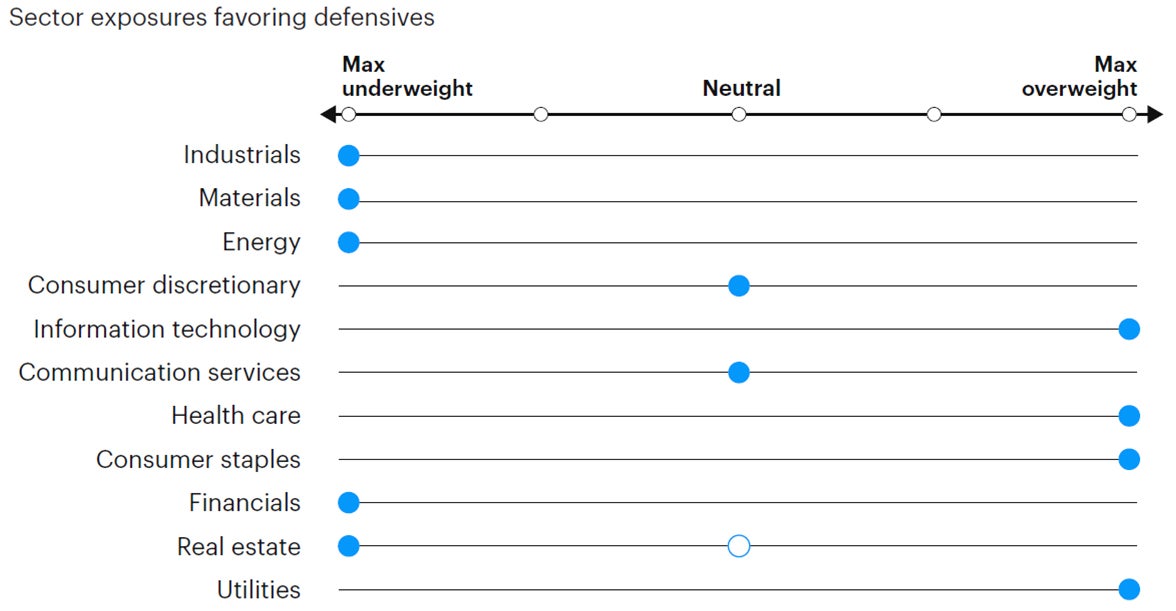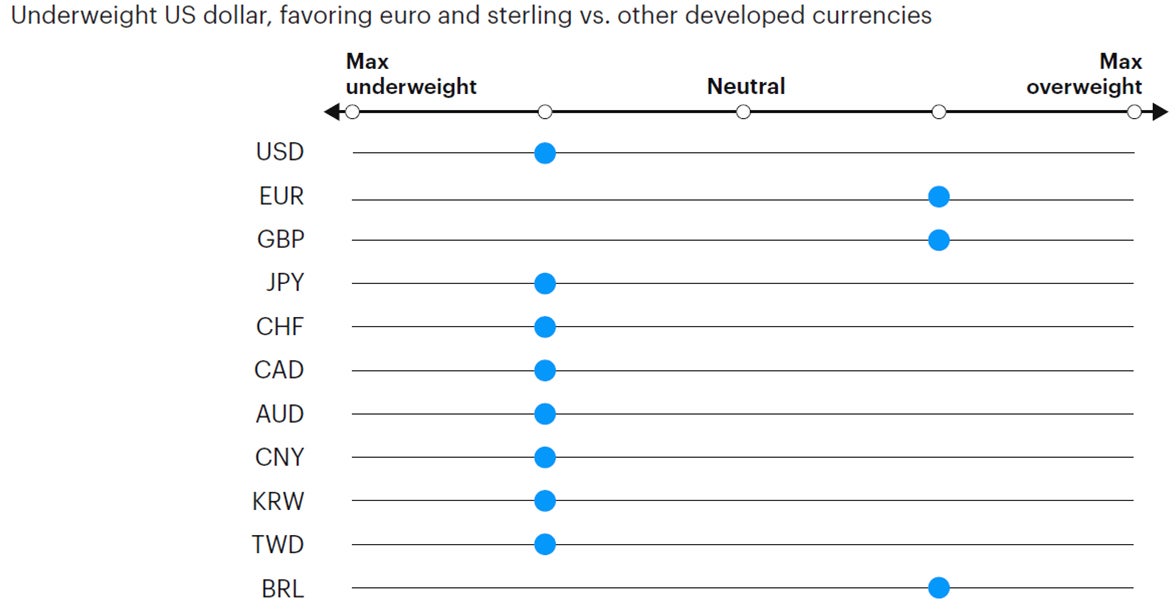Tactical Asset Allocation - July 2025

Synopsis
Despite rising concerns of US fiscal sustainability, US Treasury markets remain resilient, and bond yields continue to decline. In our opinion, US dollar depreciation remains the path of least resistance and the most likely macro adjustment to address US external funding requirements.
Our framework remains in a contraction regime for the 13th consecutive month. Global risk appetite has improved, but not enough to trigger a sustained increase in growth expectations. We maintain a defensive posture, overweighting fixed income relative to equities, favoring defensive sectors and a moderate underweight in developed ex-US equities and emerging markets. In fixed income, we maintain moderate duration overweight and underweight credit risk. We remain positioned for US dollar depreciation.
Maintaining defensive portfolio positioning, favoring fixed income over equities, and underweighting credit risk. US fiscal sustainability risks to drive dollar depreciation, more than higher Treasury yields.
Our macro process drives tactical asset allocation decisions over a time horizon between six months and three years, on average, seeking to harvest relative value and return opportunities between asset classes (e.g., equity, credit, government bonds, and alternatives), regions, factors, and risk premia.
Macro Update: Debt sustainability risks weighting on the dollar rather than yields.
Economic data around the world remain broadly stable. Developed markets are exhibiting positive momentum, led by consumer sentiment surveys, stable business surveys and improving manufacturing activity. Against this backdrop, the performance of risky assets continues to improve, with equities marginally outperforming fixed income and credit spreads tightening to lower levels than seen before the tariff announcements on April 2. While our global risk appetite indicator has moderately improved over the past month, it is yet to flag a sustained inflection point and improvement in growth expectations (Figure 1 and 2).
The lack of significant news on the economic front saw fiscal policy headlines take center stage with all eyes on the US Congress, which recently passed tax legislation that would lead to an estimated $4 trillion increase in the federal debt over the next decade. With a starting deficit at 6.5% of GDP, and government debt at approximately 120% of GDP, future funding requirements of the US Treasury are heading into uncharted territory in the post WWII era. Despite growing concerns of US fiscal sustainability, US government bonds remain remarkably resilient, delivering approximately 3.5% in total returns year-to-date.
US bond yields have actually declined between 30-50 basis points across the yield curve between 2-year and 10-year maturities, and even 30-year yields are roughly unchanged year-to-date. As outlined in our monthly updates, we believe this performance is consistent with our expectation of low growth and decelerating growth expectations. We remain constructive on the performance of fixed income relative to equities, and the case for a moderate duration overweight. From a valuation perspective, long-term yields between 4% and 5% are broadly consistent with US nominal GDP growth, mitigating concerns around US debt sustainability, at least for now.

Sources: Bloomberg L.P., Macrobond. Invesco Solutions research and calculations. Proprietary leading economic indicators of Invesco Solutions. Macro regime data as of June 30, 2025. The Leading Economic Indicators (LEIs) are proprietary, forward-looking measures of the level of economic growth. The Global Risk Appetite Cycle Indicator (GRACI) is a proprietary measure of the markets’ risk sentiment. Developed markets ex-USA include the Eurozone, UK, Japan, Switzerland, Canada, Sweden, Australia. Emerging markets include Brazil, Mexico, Russia, South Africa, Taiwan, China, South Korea, India.

Source: Invesco Solutions, as of June 30, 2025.

Sources: Bloomberg L.P., Macrobond. Invesco Solutions research and calculations. Proprietary leading economic indicators of Invesco Solutions. Macro regime data as of June 30, 2025. The Leading Economic Indicators (LEIs) are proprietary, forward-looking measures of the level of economic growth. The Global Risk Appetite Cycle Indicator (GRACI) is a proprietary measure of the markets’ risk sentiment.

Sources: Bloomberg L.P., MSCI, FTSE, Barclays, JPMorgan, Invesco Solutions research and calculations, from Jan. 1, 1992, to June 30, 2025. The Global Leading Economic Indicator (LEI) is a proprietary, forward-looking measure of the growth level in the economy. A reading above (below) 100 on the Global LEI signals growth above (below) a long-term average. The Global Risk Appetite Cycle Indicator (GRACI) is a proprietary measure of the markets’ risk sentiment. A reading above (below) zero signals a positive (negative) compensation for risk-taking in global capital markets in the recent past. Past performance does not guarantee future results.
On the other hand, as discussed in our April update, we believe depreciation of the US dollar remains the path of least resistance for markets to reflect sustainability concerns about growing US budget and current account deficits. The greenback experienced broad-based depreciation in the second quarter, relative to both developed and emerging market currencies, and we expect this trend to continue (Figure 3). The greenback is still overvalued on a fundamental basis. As illustrated in Figure 4, a return of the EUR/USD exchange rate towards 1.25 – 1.30 would be broadly consistent with long-term valuations informed by inflation differentials, with the potential to overshoot to stronger levels over the long term, in-line with historical multi-year cycles of currency adjustments. Interestingly, the negative momentum in the US dollar over the past 6-months has endured during both rising and falling equity markets, pointing to fundamental drivers for the dollar that are independent of the typical short-term risk-on/risk-off correlations. We expect this trend to continue, supported by valuations and gradually narrowing interest rate differentials between the US and the rest of the world.

Source: Bloomberg, year-to-date, as of June 30, 2025.

Source: Bloomberg, Invesco Solutions calculations. Pre-1999 EUR/USD exchange rate computed by Bloomberg as weighted average of legacy European currencies. Fair value represented by relative purchasing power parity, i.e., relative inflation differentials using headline CPI. January 1975 – June 2025

Sources: Bloomberg L.P. data as of June 30, 2025, Invesco Solutions calculations. The US Inflation Momentum Indicator (IMI) measures the change in inflation statistics on a trailing three-month basis, covering indicators across consumer and producer prices, inflation expectation surveys, import prices, wages, and energy prices. A positive (negative) reading indicates inflation has been rising (falling) on average over the past three months.
Investment positioning
We implemented no changes this month in the Global Tactical Allocation Model.1 We remain underweight risk relative to benchmark, underweighting equities relative to fixed income, primarily via an underweight to emerging markets and developed markets outside the US. We overweight defensive sectors with quality and low volatility characteristics. In fixed income, we underweight credit risk2 relative to benchmark and overweight duration, while overweighting inflation-linked bonds versus nominal Treasuries (Figures 6 to 9). In particular:
- In equities, despite ongoing US dollar depreciation, downward revisions in earnings expectations in Europe and Japan lead our models to remain underweight these cyclical markets more levered to global trade. Indeed, the outperformance of international developed markets versus US equities has stalled since April, failing to sustain the momentum in the first quarter. Similarly, we maintain a moderate underweight in emerging market equities relative to developed markets. We favor defensive sectors with quality and low volatility characteristics, tilting towards larger capitalizations at the expense of value, mid and small caps. Hence, we favor sectors such as health care, staples, utilities, and technology at the expense of cyclical sectors such as financials, industrials, materials, and energy.
- In fixed income, we underweight credit risk and overweight duration, favoring investment grade and sovereign emerging fixed income relative to high yield. Given the decelerating growth environment and historically tight credit spreads, we believe the risk-reward in this position is attractive. In sovereigns, we maintain a maximum overweight exposure to US TIPS relative to nominal Treasuries given sticky inflation momentum in the US (Figure 5).
- In currency markets, we remain underweight the US dollar, driven by narrowing interest rate differentials relative to the rest of the world and positive surprises in non-US economic data. Concerns around the deteriorating fiscal position of the US and rising funding requirements are adding to the negative sentiment towards the greenback. Within developed markets we favor the euro, the British pound, Norwegian kroner, Swedish krona, and Singapore dollar relative to the Swiss franc, Japanese yen and the Australian and Canadian dollars. In EM we favor high yielders with attractive valuations, such as the Colombian peso, Brazilian real, Indian rupee, Indonesian rupiah and Mexican peso, relative to low yielding and more expensive currencies, such as the Korean won, Taiwanese dollar, Philippines peso and Chinese renminbi.

Source: Invesco Solutions, July 1, 2025. DM = developed markets. EM = emerging markets. Non-USD FX refers to foreign exchange exposure as represented by the currency composition of the MSCI ACWI Index. For illustrative purposes only.

Source: Invesco Solutions, July 1, 2025. For illustrative purposes only. Neutral refers to an equally weighted factor portfolio.

Source: Invesco Solutions, July 1, 2025. For illustrative purposes only. Sector allocations derived from factor and style allocations based on proprietary sector classification methodology. As of December 2023, Cyclicals: energy, financials, industrials, materials; Defensives: consumer staples, health care, information technology, real estate, utilities; Neutral: consumer discretionary and communication services.

Source: Invesco Solutions, July 1, 2025. For illustrative purposes only. Currency allocation process considers four drivers of foreign exchange markets: 1) US monetary policy relative to the rest of the world, 2) global growth relative to consensus expectations, 3) currency yields (i.e., carry), 4) currency long-term valuations.
Investment risks
The value of investments and any income will fluctuate (this may partly be the result of exchange rate fluctuations), and investors may not get back the full amount invested.




